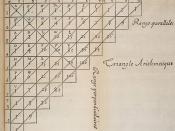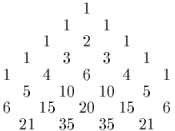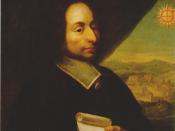pascal triangle
The Pascal triangle (actually known long before Pascal) is a table of the binomial coefficients where the (n, k)th entry is .
Each entry is the sum of the pair immediately above it.
binomial coefficient
The binomial coefficients are the coefficients of powers of x in the expansion of (1 + x)n.
We have
where the binomial coefficient is the number of ways of choosing an (unordered) subset of size k from a set of size n.
The binomial coefficients are the entries in the Pascal triangle.
binomial theorem
The Binomial Theorem is the result which allows one to expand a binomial:
(x + y)n = xn + an-1xn-1y + an-2xn-2y2 + ... + yn
where the coefficients ai are called binomial coefficients
probability theory Probability theory studies the possible outcomes of given events together with their relative likelihoods and distributions.
In fact there is considerable debate about exactly what probability means in practice.
Some mathematicians regard it as simply a component of an abstract theory, while others give it an interpretation based on the frequencies of certain outcomes.
infinitesimal An infinitesimal is an arbitrarily small quantity which early mathematicians found it necessary to incorporate into their theories in the absence of a proper theory of limits.
Infinitesimal calculus is the Differential and Integral Calculus.
projective geometry Projective geometry is the branch of geometry dealing with the properties and invariants of geometric figures under projection from a point.
So, for example, a circle may be projected into an ellipse or a hyperbola and so these curves may all be regarded as equivalent in projective geomet
Born: 19 June 1623 in Clermont (now Clermont-Ferrand), Auvergne, France
Died: 19 Aug 1662 in Paris, France
Blaise Pascal was the third of Etienne Pascal's children and his only son. Blaise's...



Pascal
Nice essay that is well formatted and includes some very interesting facts.
1 out of 1 people found this comment useful.